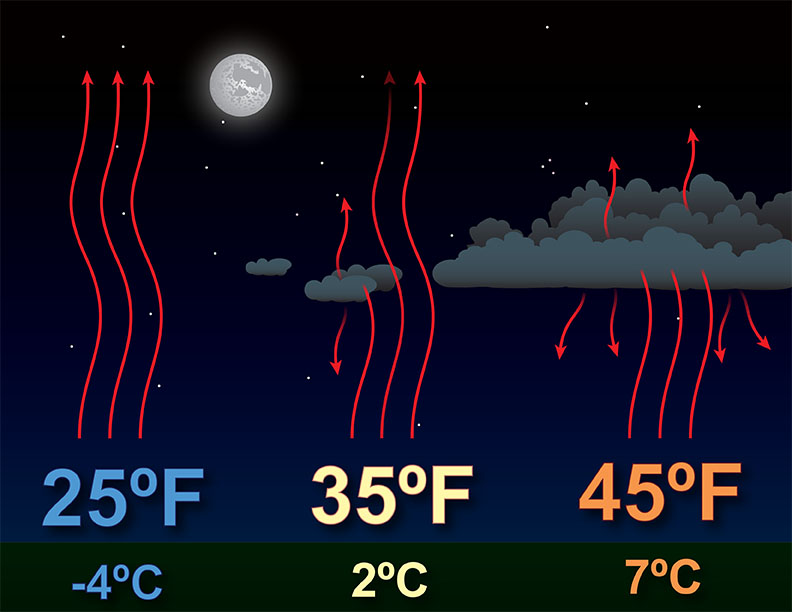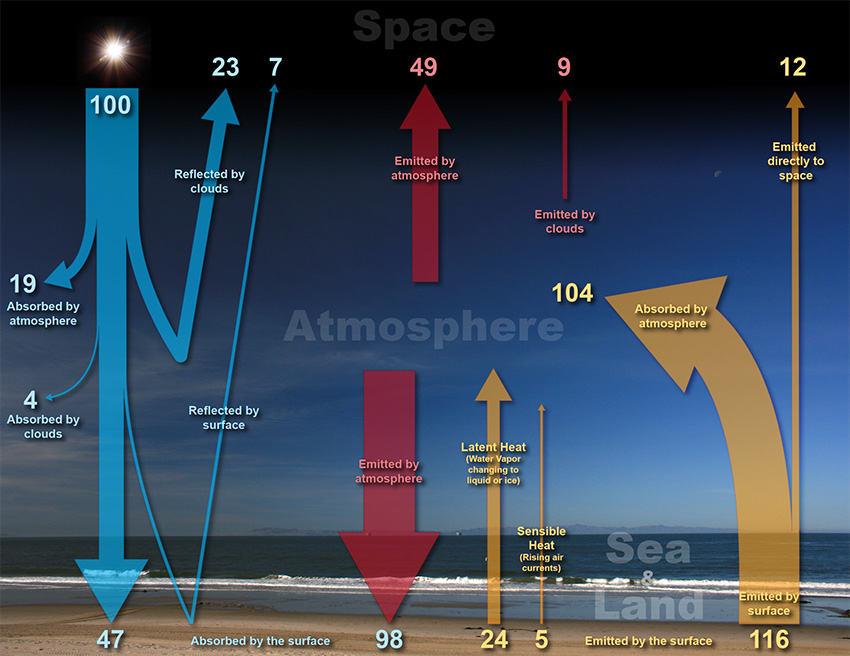

The earth-atmosphere energy balance is the balance between incoming energy from the Sun and outgoing energy from the Earth. Energy released from the Sun is emitted as shortwave light and ultraviolet energy. When it reaches the Earth, some is reflected back to space by clouds, some is absorbed by the atmosphere, and some is absorbed at the Earth's surface.
Learning Lesson: Canned Heat
However, since the Earth is much cooler than the Sun, its radiating energy is much weaker (long wavelength) infrared energy. We can indirectly see this energy radiate into the atmosphere as heat, rising from a hot road, creating shimmers on hot sunny days.
The earth-atmosphere energy balance is achieved as the energy received from the Sun balances the energy lost by the Earth back into space. In this way, the Earth maintains a stable average temperature and therefore a stable climate. Using 100 units of energy from the sun as a baseline the energy balance is as follows:

| Incoming energy | Outgoing energy | ||
|---|---|---|---|
| Units | Source | Units | Source |
| +100 |
Shortwave radiation from |
-23 | Shortwave radiation reflected back to space by clouds. |
| -7 | Shortwave radiation reflected to space by the earth's surface. |
||
| -49 | Longwave radiation from the atmosphere into space. |
||
| -9 | Longwave radiation from clouds into space. |
||
| -12 | Longwave radiation from the earth's surface into space. |
||
| +100 | Total Incoming | -100 | Total Outgoing |
| Incoming energy | Outgoing energy | ||
|---|---|---|---|
| Units | Source | Units | Source |
| +19 | Absorbed shortwave radiation by gases in the atmosphere. |
-9 | Longwave radiation emitted to space by clouds. |
| +4 | Absorbed shortwave radiation by clouds. | -49 | Longwave radiation emitted to space by gases in atmosphere. |
| +104 | Absorbed longwave radiation from earth's surface. |
-98 | Longwave radiation emitted to earth's surface by gases in atmosphere. |
| +5 | From convective currents (rising air warms the atmosphere). |
||
| +24 | Condensation /Deposition of water vapor (heat is released into the atmosphere by process). |
||
| +156 | Total Incoming | -156 | Total Outgoing |
| Incoming energy | Outgoing energy | ||
|---|---|---|---|
| Units | Source | Units | Source |
| +47 | Absorbed shortwave radiation from the sun. |
-116 | Longwave radiation emitted by the surface. |
| +98 | Absorbed longwave radiation from gases in atmosphere. | -5 | Removal of heat by convection (rising warm air). |
| -24 | Heat required by the processes of evaporation and sublimation and therefore removed from the surface. |
||
| +145 | Total Incoming | -145 | Total Outgoing |
The absorption of infrared radiation trying to escape from the Earth back to space is particularly important to the global energy balance. Energy absorption by the atmosphere stores more energy near its surface than it would if there was no atmosphere.
The average surface temperature of the moon, which has no atmosphere, is 0°F (-18°C). By contrast, the average surface temperature of the Earth is 59°F (15°C). This heating effect is called the greenhouse effect.



